
Munich South is an electoral constituency represented in the Bundestag. It elects one member via first-past-the-post voting. Under the current constituency numbering system, it is designated as constituency 218. It is located in southern Bavaria, comprising the southern part of the city of Munich.

Hof is an electoral constituency represented in the Bundestag. It elects one member via first-past-the-post voting. Under the current constituency numbering system, it is designated as constituency 238. It is located in northeastern Bavaria, comprising the city of Hof and the districts of Landkreis Hof and Wunsiedel.

Kulmbach is an electoral constituency represented in the Bundestag. It elects one member via first-past-the-post voting. Under the current constituency numbering system, it is designated as constituency 239. It is located in northern Bavaria, comprising the Kulmbach district, the Lichtenfels district, and the northern part of the Bamberg district.

Deggendorf is an electoral constituency represented in the Bundestag. It elects one member via first-past-the-post voting. Under the current constituency numbering system, it is designated as constituency 226. It is located in southeastern Bavaria, comprising the districts of Deggendorf and Freyung-Grafenau.

Augsburg-Stadt is an electoral constituency represented in the Bundestag. It elects one member via first-past-the-post voting. Under the current constituency numbering system, it is designated as constituency 251. It is located in southwestern Bavaria, comprising the city of Augsburg.
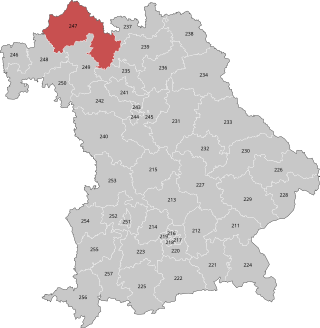
Bad Kissingen is an electoral constituency represented in the Bundestag. It elects one member via first-past-the-post voting. Under the current constituency numbering system, it is designated as constituency 247. It is located in northwestern Bavaria, comprising the districts of Bad Kissingen, Haßberge, and Rhön-Grabfeld.

Rosenheim is an electoral constituency represented in the Bundestag. It elects one member via first-past-the-post voting. Under the current constituency numbering system, it is designated as constituency 221. It is located in southern Bavaria, comprising the city of Rosenheim and the Landkreis Rosenheim district.

Bamberg is an electoral constituency represented in the Bundestag. It elects one member via first-past-the-post voting. Under the current constituency numbering system, it is designated as constituency 235. It is located in northern Bavaria, comprising the city of Bamberg, the southern part of the Landkreis Bamberg district, and the western part of the Forchheim district.

Munich Land is an electoral constituency represented in the Bundestag. It elects one member via first-past-the-post voting. Under the current constituency numbering system, it is designated as constituency 220. It is located in southern Bavaria, comprising Landkreis Munich district.

Landshut is an electoral constituency represented in the Bundestag. It elects one member via first-past-the-post voting. Under the current constituency numbering system, it is designated as constituency 227. It is located in southeastern Bavaria, comprising the city of Landshut, the Kelheim district, and most of the Landkreis Landshut district.
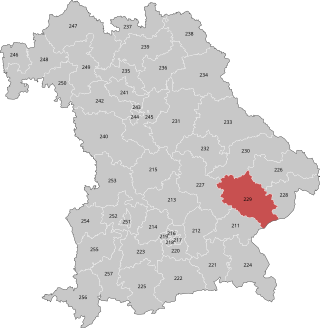
Rottal-Inn is an electoral constituency represented in the Bundestag. It elects one member via first-past-the-post voting. Under the current constituency numbering system, it is designated as constituency 229. It is located in southeastern Bavaria, comprising the Dingolfing-Landau district, Rottal-Inn district, and small parts of the Landkreis Landshut district.

Straubing is an electoral constituency represented in the Bundestag. It elects one member via first-past-the-post voting. Under the current constituency numbering system, it is designated as constituency 230. It is located in southeastern Bavaria, comprising the city of Straubing and the districts of Regen and Straubing-Bogen.

Bayreuth is an electoral constituency represented in the Bundestag. It elects one member via first-past-the-post voting. Under the current constituency numbering system, it is designated as constituency 236. It is located in northern Bavaria, comprising the city of Bayreuth, the Landkreis Bayreuth district, and the eastern part of the Forchheim district.

Coburg is an electoral constituency represented in the Bundestag. It elects one member via first-past-the-post voting. Under the current constituency numbering system, it is designated as constituency 237. It is located in northern Bavaria, comprising the city of Coburg and the districts of Landkreis Coburg and Kronach.

Ansbach is an electoral constituency represented in the Bundestag. It elects one member via first-past-the-post voting. Under the current constituency numbering system, it is designated as constituency 240. It is located in western Bavaria, comprising the city of Ansbach and the districts of Landkreis Ansbach and Weißenburg-Gunzenhausen.
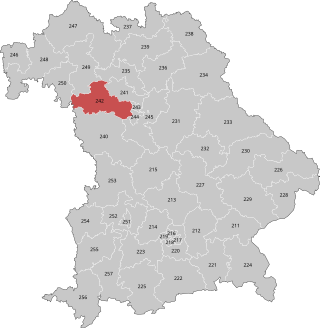
Fürth is an electoral constituency represented in the Bundestag. It elects one member via first-past-the-post voting. Under the current constituency numbering system, it is designated as constituency 242. It is located in northwestern Bavaria, comprising the city of Fürth and the districts of Landkreis Fürth and Neustadt (Aisch)-Bad Windsheim.

Schweinfurt is an electoral constituency represented in the Bundestag. It elects one member via first-past-the-post voting. Under the current constituency numbering system, it is designated as constituency 249. It is located in northwestern Bavaria, comprising the city of Schweinfurt and the districts of Kitzingen and Landkreis Schweinfurt.
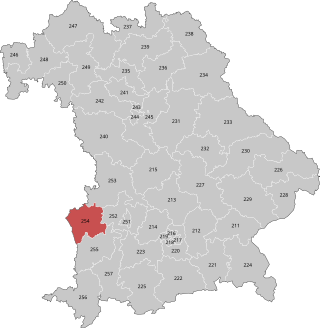
Neu-Ulm is an electoral constituency represented in the Bundestag. It elects one member via first-past-the-post voting. Under the current constituency numbering system, it is designated as constituency 254. It is located in southwestern Bavaria, comprising the Günzburg and Neu-Ulm districts.
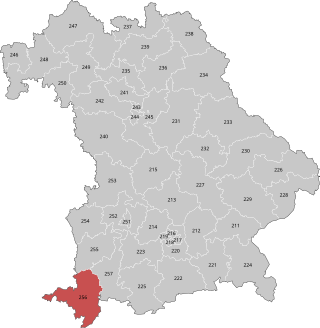
Oberallgäu is an electoral constituency represented in the Bundestag. It elects one member via first-past-the-post voting. Under the current constituency numbering system, it is designated as constituency 256. It is located in southwestern Bavaria, comprising the city of Kempten and the districts of Lindau and Oberallgäu.
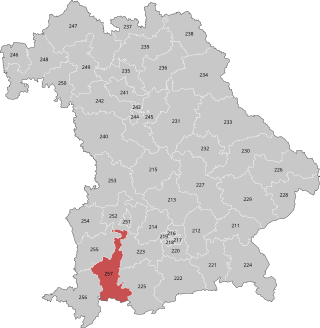
Ostallgäu is an electoral constituency represented in the Bundestag. It elects one member via first-past-the-post voting. Under the current constituency numbering system, it is designated as constituency 257. It is located in southwestern Bavaria, comprising the city of Kaufbeuren, the Ostallgäu district, and southern parts of the Landkreis Augsburg district.




















